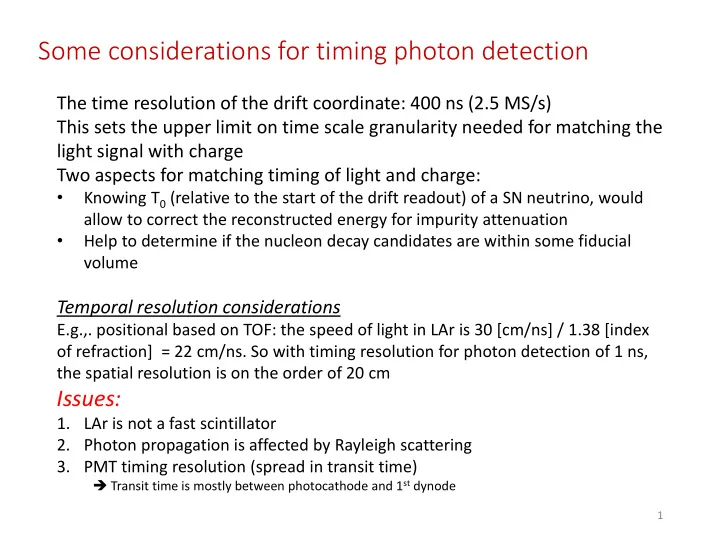

Some considerations for timing photon detection The time resolution of the drift coordinate: 400 ns (2.5 MS/s) This sets the upper limit on time scale granularity needed for matching the light signal with charge Two aspects for matching timing of light and charge: • Knowing T 0 (relative to the start of the drift readout) of a SN neutrino, would allow to correct the reconstructed energy for impurity attenuation • Help to determine if the nucleon decay candidates are within some fiducial volume Temporal resolution considerations E.g.,. positional based on TOF: the speed of light in LAr is 30 [cm/ns] / 1.38 [index of refraction] = 22 cm/ns. So with timing resolution for photon detection of 1 ns, the spatial resolution is on the order of 20 cm Issues: 1. LAr is not a fast scintillator 2. Photon propagation is affected by Rayleigh scattering 3. PMT timing resolution (spread in transit time) Transit time is mostly between photocathode and 1 st dynode 1
Properties of scintillation in LAr Number of the photons (0.5 kV/cm, e- recomb ~ 0.7): ~22 000 𝛿/ MeV Maximal number of photons (all e- recombine) : ~51 000 𝛿/ MeV Primary scintillation (S1) consists of two components with massively different lifetimes: See e.g., Hitachi et al., Phys. Rev. • Fast component: 𝜐 𝑔 = 6 ns B27 5279 (1983)) • Slow component: 𝜐 𝑡 = 1600 ns • The fraction of light going into fast / slow contribution depends on recombination effects, but for mip-like signals fast/slow ~ 30%, Even if all of the light comes from the fast component, trying to get a timing resolution at a level of 1ns for photon arrival times will depend on the number of detectable photons The resolution for TOF with scintillator emission probability 𝑓 −𝑢/𝜐 and n arriving photons is: 𝜏 = 𝜐/𝑜 In case of single photon detection timing resolution is given by 𝜐 2
Rayleigh scattering • According the latest analyses: 𝜇 𝑆𝑇 ~ 60 cm • The scattering is largely isotropic, i.e., photons are as likely to scatter in any direction • For large source-detector distances the photon arrival time is not simply given by 𝑒/𝑤 , but is longer because of non-negligible path variations due to the RS scattering Photon arrival time distributions 𝝁 𝑺𝑻 = 𝟔𝟔 cm Source 1m away Source 5m away Calculated PDF Generated For large distance RS could smear the photon transit time by tens of ns 3
Spread in transit time • The transit time is (surprisingly) long for R5912-mod2 68 ns • The FWHM is ~3 ns Sets a limit on a precision for photon timing measurements 4
Photons per 8” detector No attenuation, no cathode opacity PMT plane is 100 cm below the cathode plane Simple calculation ~1/D 2 Simulation with 𝜇 𝑆𝑇 = 55 cm and 12x12x12 m 3 volume 5
Photons / m 2 in detection plane PMT plane is 100 cm is below cathode (at 0) The number of PE that could be detected can be roughly estimated as 𝑂 𝑞𝑓 ≈ 𝑂 𝑒 × 0.0314 × 0.5 × 0.2 × 𝑂 𝛿 = 𝑂 𝑒 × 3𝑂 𝛿 /1000 QE Photons / m2 Number of detectors per WLS (1/2 of photons / m2 x effective det area are emitted up) 6
Photons / m 2 in SN neutrino spectrum detection plane < 1PE / det / 10 MeV e Benetti et al., NIM. A574 (2007), 83-88 • Large variation in sensitivity to over the drift volume: O(100) variation • Effect of radiological backgrounds? Ar39 is 1Bq/kg 1400 Bq/m 3 7
Summary • For light-charge signal association a timing resolution on light signals should not be greater than 400 ns = sampling of the charge readout • Timing resolution for a detection at a few photon level is limited by physics of the light production and propagation in LAr and the time response of the PMT • For large detector volumes RS would dominate achievable timing resolution 8
Recommend
More recommend